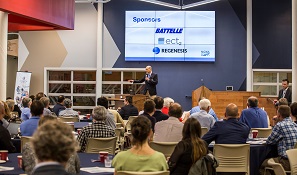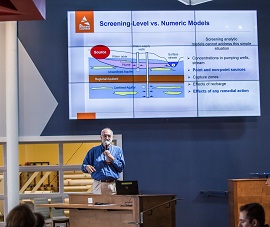
PFAS has moved to the front burner according to the first speaker on the last day of NGWA’s PFAS Management, Mitigation, and Remediation Conference, June 20, in Westerville, Ohio.
The final day of the event, which featured more than 100 attendees, led off with the plenary session, “Contaminants and Compliance: The 30,000 Ft. Perspective” by Jeff Rose and Amy Dindal of Battelle.
Rose, the vice president of government affairs at Battelle, opened the talk by saying “PFAS has gone from not being on the radar to being on the back burner and is now going to the front burner.”
He then went over the legislative action on PFAS — per- and polyfluoroalkyl substances — taking place in Washington, D.C., as well as in state capitals. At the federal level, there have been 32 PFAS-related bills introduced so far in 2019 — after a total of 17 were introduced in the previous five Congresses.
Dindal, the PFAS program manager at Battelle, compared and contrasted PFAS to other federally regulated environmental contaminants and discussed some difficulties of PFAS remediation technologies, including large plume sizes, solutions being energy-intensive and costly, and the difficulty of chemistry breaking down the carbon-fluorine bond.
She concluded by saying, “We are on the front end of the journey, which is likely to be long. These unique chemicals are likely to require new thinking and new technology.”
Their presentation was followed by that of their colleague at Battelle, Ryan James, Ph.D., whose talk was titled “Regeneration of Granular Activated Carbon used for Polyfluorinated Substance (PFAS) Remediation.”
Granular activated carbon is commonly used for treatment of PFAS but cannot currently be regenerated without removal from a system. James went over tests at Battelle that have yielded data that shows there is a possibility for this to come to fruition, which would significantly reduce lifetime costs of treatment.
 The day featured multiple presentations on mitigation and remediation.
The day featured multiple presentations on mitigation and remediation.
Another highlight was a panel titled “PFAS — the Water Supply Perspective” that included comments from Jennifer Gray, Ph.D., of the Michigan Department of Health and Human Services, David Harn of the State of Michigan-EGLE, Richard Head, J.D., of SL Environmental Law Group, and Roderick Dunn of the Water Quality Assurance Laboratory. The panel was moderated by Avram Frankel, PE, of Integral Consulting.
Discussed was how PFAS has quickly become the MTBE of this decade and most states are struggling to ensure safe, potable water supplies for their residents. The panelists offered perspectives from their experiences on potential paths to dealing with these challenges.
The two-day event began on June 19 and was highlighted by a keynote address from Robert “Rob” A. Bilott, J.D., a partner at Taft Stettinius & Hollister LLP, who brought the very first PFAS environmental exposure case to the forefront in 1999. Doing so resulted in the discovery and public disclosure of PFOA (perfluorooctanoic acid) in drinking water supplies for approximately 70,000 people in West Virginia and Ohio, and that discovery spurred national regulatory interest and investigation into PFAS.
PFAS has been on NGWA’s radar for several years and will remain a priority issue for the foreseeable future. The Association has created an online Groundwater and PFAS resource center, which includes PFAS FAQs, top 10 facts about PFAS, and a homeowner checklist, among other items. NGWA is also the publisher of the guidance document, Groundwater and PFAS: State of Knowledge and Practice.